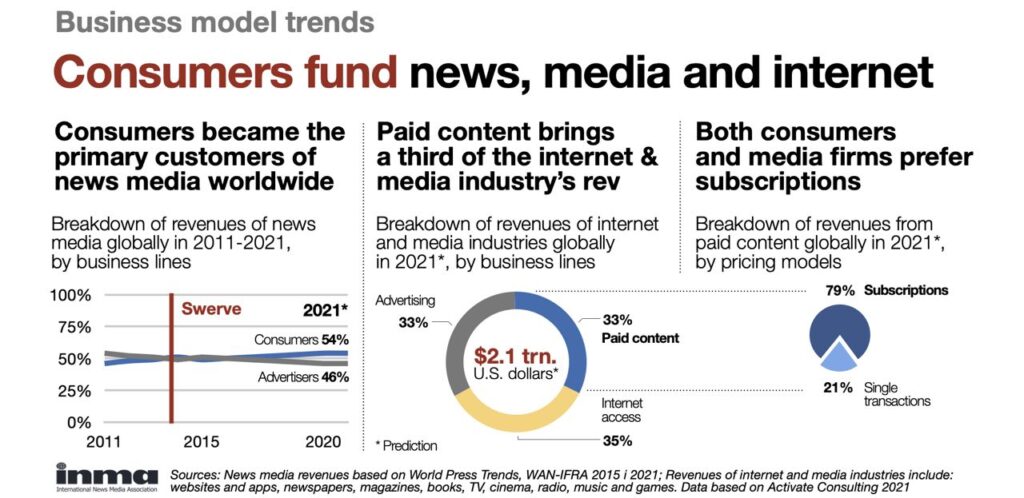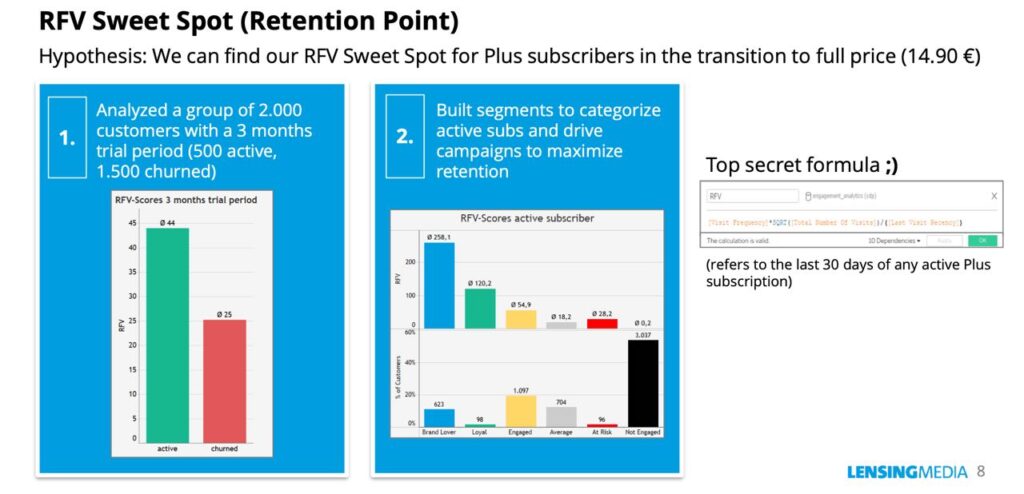Above: Scottish publisher DC Thompson summarised the subscription evolution process in this graphic for their presentation.
BitDepth#1339 for January 31, 2022
On December 09, 2021, the International News Media Association (INMA) hosted a media subscriptions town hall to discuss the results of an eight-month lab for publishers in Europe.
There are main three models being pursued by publishers, revenue from advertisers, revenue from readers and support through public service funding.
According to Greg Piechota of INMA, during the covid19 crisis demand for online news grew dramatically and publishers translated that higher demand into subscriptions, registering a 95 per cent growth in online news subscriptions.
Brands that began running subscription programmes over the last three to six years registered growth of over 300 per cent.
Mature subscription programmes running for more than six years logged the lowest increases, suggesting that relative newcomers, willing to be nimble in their approach, can improve their subscription numbers dramatically.
Why are subscriptions important?
They establish an important link between news creators and consumers. With the collapse of online advertising for media companies, 2015 marked the break point for a shift in revenue emphasis from advertisers, currently at 46 percent of the revenue pie relative to consumer-derived income.
Of all the ways that media firms can engage with consumers for revenue, subscriptions have emerged as the most favored.
Eight European publishers worked on the programme, working through every step of the subscriptions process from discovery through to conversion and retention.
The event was produced in collaboration with Google News and FT Strategies.
“For the Financial Times, the customer is the reader, not the advertiser,” said Tara Lajumoke, Managing Director FT Strategies, UK.
While the company has a healthy advertiser, subscription and events ecosystem, Lajumoke acknowledged that, “Its almost impossible to serve every customer equally at every point in time, so for us, there is a lot of work around emphasising who the priority customer is.”
In creating one of the most successful subscription systems in modern media, FT emphasised the development of skillsets in data, analytics, marketing, pricing, editorial and creating new editorial products.
Today, half of the skills in use at FT didn’t exist in the company at all a decade ago.
To encourage the building of these new skills, FT encouraged the formation of cross-functional teams that worked across departments and introduced the new concepts to the business.

“We sent a very clear signal by appointing a Chief Data Officer to the board,” ” said Lajumoke.
“A hallmark of success is agility, the ability to respond quickly to deploy the assets and the capabilities that you have more efficiently than your competitors.”
Martin Prinz, Head of Subscriptions, Oberosterreischische Nachtrichten, Austria a participant in the workshops, explained that the company is targeting volume in subscriptions.
“The multidisciplinary team is made up of marketing, editorial, product and tech,” Prinz said while acknowledging that the newsroom should be more integrated into the projects underway.
“If the content isn’t relevant enough or exclusive enough for our readers, they don’t convert (to paid subscriptions).”
Once you are in the subscriptions game, you are no longer competing with local media, you are in competition with everyone offering paid news in the news space that you occupy, so the competitive stance has to evolve from local to global in one significant jump.
The Irish Independent, another workshop participant, began subscriptions for its digital product recently.
“It’s strange to think that in February 2020, a newspaper that’s well over a hundred years old had its first B2C customer,” said Ronan Doyle, the paper’s Retention Manager.
“Previously we sold the paper to shops, and they had the relationship with customers.”

“Overseas diaspora audiences are particularly important for Ireland, so we need to research, build out and understand where the growth opportunities are.”
“An individual publisher has to put forward a consistent proposition and hope that readers who are dipping in through aggregators will come across to your publication and begin to like certain content and certain authors.”
“People have a degree of brand loyalty if there’s a product and content that they really appreciate.”
How are subscriptions best introduced?
First, launch subscriptions as a minimum viable project, with low expectations, and a high degree of observation, explained Piechota.
Second, design a product to market fit, adjusting content, product and marketing to match customer expectations, which may require adjusting resources and the operating model of the business.
Finally, scale on successes. Introduce new technology, talent and work methods, which constitutes nothing less than a reinvention of the company.
The demand for news follows cycles, so journalism should be actively promoted during downtimes to create push when consumer pull is reduced.
News providers are also vulnerable to social media predation on their content, even if they do not share stories on those channels.

Publico of Portugal began its subscription channel in March 2020.
Guida Marques Pinto, Publico’s Digital Innovation Director advocates for measurement of Reader Frequency Volume a metric that measures loyalty and engagement by tallying how often a reader visits the site and how much content they view during a visit.
“Our first mission is to better understand our readers, to unmask them, to better understand their needs,” said Lenka Gallo, Manager Subscription Marketing at Denik in Czechia.
Denik hopes to do that by using a registration wall to collect information about subscribers, which they will use to create segments and personas for their readers.
To do that, they plan a training programme to coach staff in the digital skills necessary for this aspect of the marketing effort.
Denik will also create engagement metrics to target free subscribers likely to become paid subscribers. Denik puts just 20 per cent of its content behind its paywall.
The company is developing its value proposition for subscribers, which will include less advertising for paid subscribers in addition to access to the restricted content.



